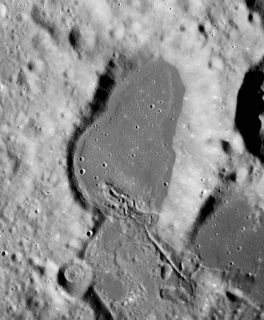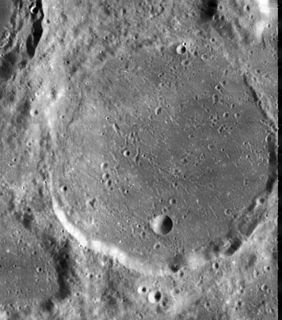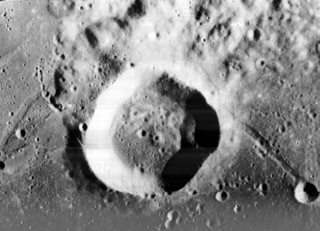
Abel is an ancient lunar impact crater that lies near the southeast limb of the Moon's near side. It is located to the south of the crater Barnard, at the northwest edge of the Mare Australe.

Barnard is a lunar impact crater that is located near the eastern limb of the Moon. It is attached to the southeast rim of the large crater Humboldt, and Abel lies directly to the south. To the northeast is the crater Curie, while to the southeast is the Mare Australe.

Chamberlin is a lunar impact crater that is located on the far side of the Moon, just past the southeastern limb. It lies to the southeast of the crater Jeans, and Moulton is attached to the southeastern rim of Chamberlin. This crater is located in a part of the lunar surface that has undergone resurfacing of crater interiors, producing dark-hued crater floors.

Bowditch is a lunar impact crater that lies on the far side of the Moon, just beyond the eastern limb. It is located on a region of the lunar surface that is brought into view due to libration, but at such times the area is viewed from the edge and so not much detail can be observed. It lies just to the north of the small Lacus Solitudinis lunar mare, between the craters Titius to the southwest and Perel'man to the east-northeast.

Brisbane is a lunar impact crater that is located in the southeastern part of the Moon, to the south of the crater Peirescius. To the northwest lie the craters Vega and Reimarus, and farther to the east is the walled plain Lyot. Due to its proximity to the limb, foreshortening of this crater causes it to appear somewhat elliptical in shape, even though it is actually circular.

Blackett is a lunar impact crater that lies on the far side of the Moon, behind the southwest limb. It lies beyond the southeast outer ring of the immense Mare Orientale basin. The formation of that major feature has left Blackett deeply marked with ridge features trending from the northwest. Much of the crater has been shaped by the ejecta from Mare Orientale, particularly along the western half of the crater.

Brunner is a lunar impact crater that is located along the eastern limb of the Moon, to the southeast of the Mare Smythii. At this location the crater is viewed from the edge, and so it is not possible to see much detail from the Earth. The visibility of this formation is also affected by libration. The crater lies to the southwest of the walled plain Hirayama, and to the east of the elongated crater Houtermans.

Cannon is a lunar impact crater that is located near the east-northeastern limb of the Moon's near side. It lies just to the northwest of the Mare Marginis, and south-southeast of the crater Plutarch. Farther to the east-northeast is Hubble.

Casatus is a lunar impact crater that is located near the southern limb of the Moon. The north-northeast rim of the crater overlies a portion of the slightly larger crater Klaproth. Along the western rim, Casatus A intrudes somewhat into the interior, producing an inward-bowing rim. To the southeast of Casatus is Newton.

Demonax is a lunar impact crater near the southern limb of the Moon. This location makes the crater difficult to observe due to foreshortening. The crater is also illuminated at a very low angle, when it is in the sunlit side. Demonax lies just to the north of the crater Scott, one of the south polar formations. To the north-northwest is Boguslawsky.

Cassegrain is a lunar impact crater that is located on the far side of the Moon, beyond the southeastern limb. It lies to the southeast of the larger crater Lebedev, and to the northeast of the comparably-sized Priestley.

Lorentz is a huge lunar impact crater that lies just beyond the northwest limb of the Moon, in a region that is brought into sight of the Earth during favorable librations. This formation is nearly as large as the Mare Nectaris on the near side of the Moon, although it has not been submerged by lava as have the lunar mare. Sections of the crater floor are, however, relatively level, particularly an arc along the western rim. But this last region is still marked by a number of tiny craterlets. The remainder of the interior is rough and irregular, and marked with a multitude of impacts.

Lamb is a lunar crater that lies beyond the southeastern limb on the Moon's far side. It is located in an irregular lunar mare region named Mare Australe, just to the east of the crater Jenner.

Eimmart is a lunar impact crater that is located near the east-northeastern limb of the Moon, to the northeast of the Mare Crisium. The northern and eastern outer rim of this crater borders on the narrow Mare Anguis. To the northwest of Eimmart are the smaller crater Delmotte and the prominent Cleomedes.

Hubble is a lunar impact crater that lies very near the east-northeastern limb of the Moon. At this location it is viewed almost from the side from Earth, and the visibility of this feature is affected by libration. It lies to the north of the Mare Marginis and northeast of the crater Cannon. About one crater diameter to the north-northeast is Lyapunov.

Hartwig is a lunar impact crater that is located near the western limb of the Moon. It is attached to the eastern rim of the prominent crater Schlüter, to the northeast of the Montes Cordillera mountain range that surrounds the Mare Orientale. To the east-northeast of Hartwig is the larger crater Riccioli.

Gum is a lunar impact crater that is located near the southeastern limb of the Moon, and is viewed nearly from the side from Earth. It lies along the western edge of the irregular Mare Australe, to the northeast of the crater Hamilton. To the north-northwest is the larger Abel, and to the east-southeast on the far side of the Moon is Jenner.

Hamilton is a lunar impact crater that is located near the southeastern limb of the Moon. From the Earth this crater is viewed nearly from the edge, limiting the amount of detail that can be observed. It can also become hidden from sight due to libration, or brought into a more favorably viewing position.

Jeans is a lunar impact crater, on the southeastern limb of the Moon, with its majority lying on the far side. A favorable libration can bring the entire crater into view, but even then the details observable from Earth are very limited as the crater is viewed rather "edge-on".

Donner is a lunar impact crater on the far side of the Moon. It is located just to the northeast of the Mare Australe, behind the southeastern limb of the Moon. During favorable librations this part of the lunar surface can be brought into view of the Earth, but the site is viewed from the edge and so not much detail can be seen.





























